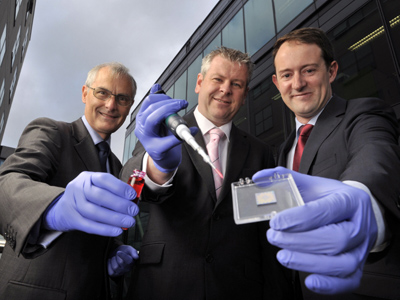European Commissioner for Research and Innovation Máire Geoghegan-Quinn
European Commissioner for Research and Innovation Máire Geoghegan-Quinn was in Ireland yesterday to visit Tyndall National Institute, where she gave a heads-up on the EU’s new research budget, as the EU moves towards creating an Innovation Union.
She said the EU needs to prioritise research and innovation as the motor for growth. In addition, Geoghegan-Quinn also spoke about how conditions need to be improved so Europe is more attractive for scientists and entrepreneurs.
Speaking yesterday at Tyndall Commissioner Geoghegan-Quinn also gave an advance look at EU’s new Research budget and says Tyndall is ideally placed to benefit.
Bridging the science and industry gap
She said that Tyndall’s “long-proven capacity as a research provider to bridge the gap between science and industry makes” makes the institute an ideal player in the key enabling technology (KEY) arena, which has fierce global competition.
Geoghegan-Quinn pointed to how Tyndall is an exemplar in how its transfers research to the commercialisation stage.
“Tyndall has clearly demonstrated that we can achieve Europe’s full potential if we integrate research and innovation and provide seamless and coherent support from idea to market.”

Prof Roger Whatmore and Dr Alan O’Riordan of Tyndall National Institute, pictured with Minister Séan Sherlock in September after Tyndall researchers pioneered a new nanosensor technology that can be up to 1,000 times more sensitive at detecting biological molecules. This nano tech may indicate the early stages of certain diseases than current devices. The research was funded by Science Foundation Ireland and the EU Framework Programmes
Track record of industry engagement
She said that the many scientific and technological breakthroughs being made at the institute are “testimony” to the quality of research conducted.
“However, it is the application of that research and your track record of industry engagement that sets you apart,” she said.
“This is precisely the philosophy behind the Innovation Union initiative that I launched last year. Our goal is no less than to make the European Union an Innovation Union.”
Innovation Union, explained Geoghegan-Quinn, is a programme of detailed policy proposals and actions to be undertaken at the European level, in the member states and regions, and by governments, administrations, research institutes, universities and companies.
Frontier and blue-sky research transfer
“Innovation Union aims to strengthen every link in the innovation chain, from “frontier” or “blue sky” research, to the transfer of this research into successful commercial products and services. In other words: creating a smooth path from lab to market.”
Geoghegan-Quinn said the the EU needs to prioritise research and innovation as growth driver.
“We need an integrated and strategic approach, whereby our objectives shape our policies in all relevant areas, an approach whereby research and innovation policy is steered at the highest political level. We got that high-level steer when Innovation Union was enthusiastically endorsed by European Union leaders during their Summit discussions on research and innovation at the beginning of the year.”
Attracting scientists and entrepreneurs
Then, she said the Commission is focusing on improving conditions so that Europe is more attractive for scientists and entrepreneurs.
“We are taking action at European level on key issues such as completion of the European Research Area; a European patent, public procurement of innovative products and services, better access to financing, and the creation of a digital single market.
Safeguarding investments
Then she said that while it is necessary to reduce deficits, it is also critical to safeguard investment in areas on which our future economy will depend.
“This is “smart” fiscal consolidation: we cannot risk our future growth and competitiveness by cutting back now on the investment in education, research and innovation that is necessary for long-term and sustained recovery. Investment in these areas has the potential to create more wealth and jobs than it costs.”
But, Geoghegan-Quinn said it is not enough to maintain or increase investment.
“We need to make it more effective, and get more innovation for our euro. We need to make these investments more effective by modernising our university systems and strengthening collaboration between academia and industry – UCC and the Tyndall Institute are beacons of excellence in this respect. We must nurture high growth companies, and better use public support to leverage private investment in innovation.”
She said most of the key policy decisions and actions needed to create an Innovation Union must be taken at national and regional level.
“Achieving a true innovation economy may require reforms across a wide range of policy areas – education, skills, taxation and many others.
We are asking member states and regions, research institutes, universities and companies to do a lot, to carry out deep-rooted reform. But we are not shirking our responsibility to take firm action at European level. We are committed to a smart EU budget, a modern and forward-looking budget, to support Innovation Union.
“This is the only kind of budget that we can justify to taxpayers, and in times of austerity, we will invest public money even more efficiently – we cannot attract the most brilliant scientists and most innovative companies with an incoherent set of funding instruments, or with complex and bureaucratic rules. Cutting red-tape means that EU-funded scientists can spend more time in the lab,” added the Commissioner.
Next week, the European Commission will propose to the member states and the European Parliament a new policy instrument – Horizon 2020 – to begin when the current 7th Framework Programme for Research ends in 2013.